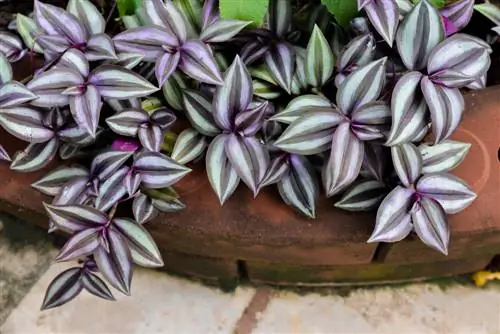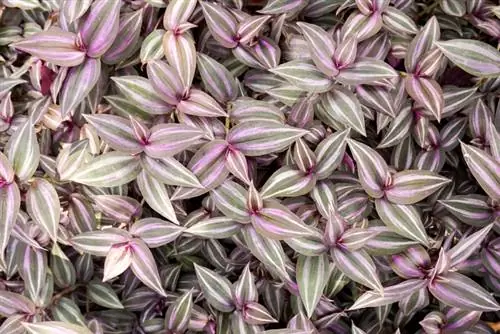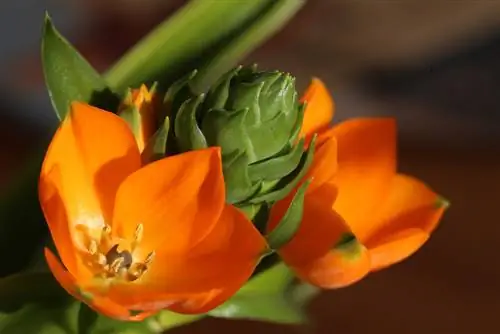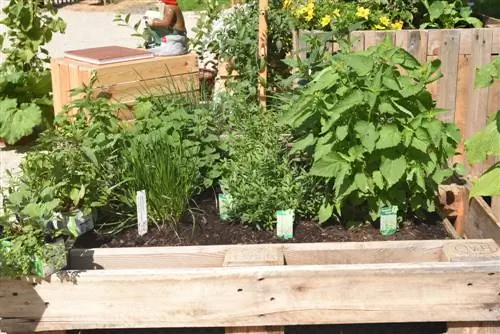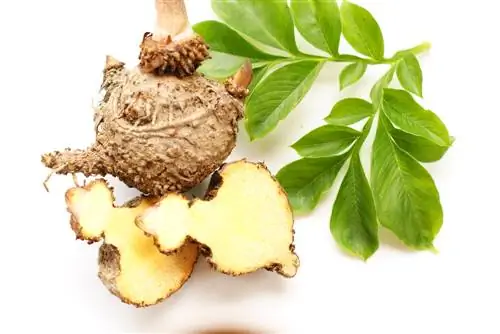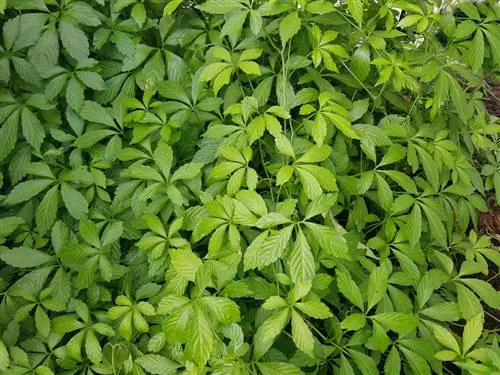- Author admin [email protected].
- Public 2023-12-25 17:45.
- Last modified 2025-06-01 06:02.
For those who love stripes among hobby gardeners, zebra herb is a real gem. The tropical perennial fascinates with its attractive structures and can be a beautiful and easy-care addition to winter gardens etc., especially in hanging baskets.
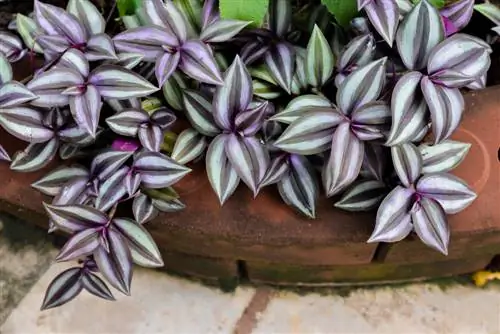
What is zebra weed and how do you care for it?
Zebraweed (Tradescantia zebrina) is an attractive, easy-care tropical houseplant or hanging basket plant known for its striped leaves in various shades of green and silvery white. It requires bright, partially shaded locations and should be watered regularly to avoid waterlogging.
Origin
The zebra herb (botanically Tradescantia zebrina) is also known under the name three-mastiff flower or under the Germanized genus name Tradeskantie, which is actually an overgeneralization. After all, it is just one of many three-master flowers (Tradescantia). The reason for this overgeneralization is that of all its members it is the most popular among ornamental gardeners. This is not only due to its high decorative value, but also to its easy-care character.
The zebra herb originally comes from Central and South America, primarily from Mexico and Guatemala, but it can also be found further south as far as Panama and on the Caribbean islands. There it mainly inhabits the tropical forest areas in lower parts of the country. It is used to a warm, humid climate and semi-shady lighting conditions, so it can only feel comfortable with us as a houseplant all year round.
To remember:
- Zebraktraut most popular representative of the three-master flowers
- High leaf jewelry value
- Comes from tropical forest areas of Central and South America
- In this country it can only be cultivated indoors all year round
Growth
The zebra herb is a slightly succulent perennial with typically long, creeping to hanging shoots. Because of them, the plant is a prime candidate for the hanging basket. It creates a very decorative image, especially thanks to the pretty striped structure and the dark, red-violet undersides of the leaves. Another argument for growing in hanging baskets is that the succulent, segmented shoots do not break off so easily when hanging when you walk close to them.
In soil cultivation, the shoots form a dense plant mat through their own sinkers. This makes them suitable, for example, as underplanting for larger winter garden plants in pots.
Growth characteristics in keywords:
- Lightly succulent perennial with long, creeping or hanging shoots
- Very suitable for hanging baskets
- Striped leaf structure
- Forms plant mats by lowering them, so can also be used as ground cover
leaves
The long hanging or creeping shoots are stemless and have an oval, tapering shape 4 to 10 centimeters long. Their surface is slightly hairy and the underside is smooth. The zebra herb gets its name from the decorative longitudinal stripe structure on the upper side of the leaves, which appears in elegant silver-white and bluish green. The undersides stand out in dark purple. Some varieties also show a more purple stripe color on the surface on the green background.
Leaf properties at a glance:
- Leaves stalkless, oval and tapering
- 4 to 10 cm long
- Hairy surface, smooth underside
- Silver-white-dark green or violet-green longitudinal stripe structure
- Underside in dark purple
Flowers
If you keep a zebra herb indoors in this country, you shouldn't hope too much for flowers. They only form under conditions that are very similar to their origin. If you can provide the perennial with such conditions, it may thank you with small but pretty pink flowers with three petals. They can appear all year round.
Flowers at a glance:
- Rarely trained in indoor culture
- Small, three-leaf structure
- Color Pink
- Available all year round
Fruit
The small capsule fruits are of course just as rarely grown in indoor cultivation.
Which location is suitable?
Like so many houseplants from the tropics, zebra herb needs a bright but not full sun location. A window seat with light shade from neighboring plants or a light curtain is best. A little gentle morning or evening sun will not harm the plant. In general: the more colorful the variety, the brighter it should be, the greener the variety, the shadier the location should be.
Practical for plant lovers: Zebra herb, like himself, feels most comfortable at normal to warm room temperature. 20 to 24°C is ideal. In winter there needs to be a slight reduction in temperature. A suitable place to spend the winter is a window seat in an unheated stairwell where the temperature is around 12 to 15°C.
In summer you can also put/hang your zebra herb outside for a certain amount of time if the temperature doesn't differ too much from the usual room temperature. Here too, you should protect it from direct sun.
Location request coming soon:
- Typically tropical location preferences: bright, but sunny
- Warm room temperature from 20 to 24°C
- Slightly cooler in winter, around 12 to 15°C
What soil does the plant need?
The zebra herb does not place any unusual demands on its substrate. You can use regular potting soil. Hydroponics is also an alternative - especially for frequent travelers.
Watering zebra herb
The zebra herb is used to tropical conditions - so make sure that its root ball is always well moistened. Nevertheless, waterlogging should be avoided as much as possible because the roots can easily rot. If the root ball dries out completely, it usually doesn't matter; if the dryness occurs more frequently, the zebra herb complains in the form of brownish, dried leaf edges. Like many tropical plants, the zebra herb also welcomes the occasional lukewarm spray from the water disperser. For this and for watering, use soft, lime-free water if possible.
During the wintering phase, limit watering so that the soil does not dry out completely.
Casting practice at a glance:
- Watering according to tropical conditions: keep the root ball continuously moist
- Do not overwater or let it dry out frequently
- Feel free to spray from time to time
- Use as soft, low-lime water as possible
- Watering sparingly in winter quarters
Fertilize zebra herb properly
Zebra herb does not have a particularly high nutrient requirement. Fertilizer application is only appropriate from the second year of cultivation or after repotting. To do this, either use commercially available green plant fertilizer (€7.00 on Amazon), which you add to the irrigation water, or fertilizer sticks. You do not need to fertilize more frequently than every 4 weeks during the growing season. In winter you can avoid it altogether.
To remember:
- Nutrient requirements of zebra herb moderate
- Fertilize only from the second year of cultivation or after repotting
- Use liquid green plant fertilizer or fertilizer sticks
- Fertilize only about every 4 weeks throughout the growing season
Cut zebra weed correctly
The lower leaves on the long shoots are shed as they age, so that the zebra herb soon becomes bald. That doesn't look nice anymore. In order to promote fresh shoots and more compact growth, you can cut such shoots back far in the spring. Since the zebra herb grows quite quickly, the sadly reduced appearance doesn't last too long.
Propagate zebra weed
A zebra herb plant can be propagated quite easily using the cutting method. It is also a recommended alternative to radically pruning bald specimens. The best way to do this is to simply cut off a he althy shoot in late spring and place it in a glass of water. Roots can then form from the shoot nodes after just 24 hours. You then only need to place the rooted shoot in a cultivation pot with potting soil and keep it moist regularly.
Alternatively, you can also stick the cutting in a moist substrate made of peat and sand. Because it roots so quickly, this variant of zebra herb is no more complicated than water rooting. After about 2 to 3 weeks, the young plants can be transplanted into pots with normal potting soil and cultivated further.
Propagation at a glance:
- Zebra herb can be easily propagated using the cutting method
- Cuttings root quickly
- Either in a moist peat-sand substrate or in a glass of water
Diseases/Pests
Zebra herb is not particularly susceptible to diseases or pests. Occasionally it can be attacked by aphids. These parasites pierce the leaves of their host plant and suck their sap. Like scale insects, they also excrete sticky honeydew, which you can use to immediately recognize the infestation. If this coating is not counteracted in time, sooty mold fungi can also settle underneath. Aphids can multiply explosively, especially in warm, dry environments. Therefore, as a preventive measure, ensure regular watering and occasional over-spraying.
Aphids are best fought mechanically by rinsing them off the plant with water. It is best to cut out severely damaged shoots. For more advanced and/or stubborn infestations, you can also use a neem oil-based preparation.
Is zebra weed poisonous?
The zebra herb is not poisonous - so pet owners and parents do not have to go without the charming hanging perennial.read more
Tip
In order to prevent premature growth, it is recommended to regularly break off the shoot tips.
Varieties
The zebra herb comes in several different cultivars, which are particularly diverse in the color and structure of the leaves. In addition to single-striped versions, there are also multiple-striped versions, and the colors have one or two slightly different shades and sometimes more silver-white, sometimes more violet parts. Almost completely green varieties are also available. Here you can choose according to your personal inclinations and creative combination aspects.
Tradescantia zebrina ‘Purpusii’
As the variety name suggests, the leaf color here concentrates on the purple parts, which turn a little pink here. Stripes in silver and white are completely absent here. The underside appears a bright, reddish purple. Overall, the leaves are slightly larger than those of its fellow varieties. The flowers, when they form, are white and have a pinkish tinge.
Tradescantia zebrina ‘Quadricolor’
Here, too, the name says it all: this variety of zebra herb presents itself with four colors and irregular stripes in purple, creamy white, green and silvery white, making it a particularly attractive eye-catcher. To ensure that the beautiful play of colors is well expressed, you should place or hang this variety as brightly as possible.
Tradescantia zebrina ‘Discolor’
This variety has a very variable striped structure with green, creamy white and pearly shimmering pink. It may appeal to all those who enjoy disorderly color play in their plant oasis.

